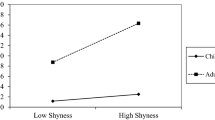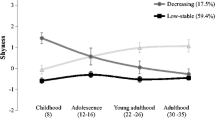Abstract
Although childhood shyness has been linked to social anxiety problems, the factors playing a role in this association have gone largely unexplored. Here we examined the potential moderating roles of sex and age on this relation in a sample of 119 (75 girls) children (10–12 years) and adolescents (14–16 years). As predicted, shyness was positively associated with social anxiety symptoms. Sex, but not age, served as a moderating factor in linking shyness and social anxiety. Specifically, shyness was more strongly associated with social anxiety symptoms among girls than boys. These results suggest the importance of considering sex differences when examining the relation between shyness and social anxiety in childhood and adolescence.

Similar content being viewed by others
References
Schmidt LA, Buss AH (2010) Understanding shyness: four questions and four decades of research. In: Rubin KR, Coplan RJ (eds) The development of shyness and social withdrawal. Guilford Publications, New York, pp 23–41
Rubin KH, Coplan RJ, Bowker JC (2009) Social withdrawal in childhood. Annu Rev Psychol 60:141–171
Chronis-Tuscano A, Degnan KA, Pine DS, Perez-Edgar K, Henderson HA, Diaz Y et al (2009) Stable early maternal report of behavioral inhibition predicts lifetime social anxiety disorder in adolescence. J Am Acad Child Adolesc Psychiatry 48:928–935
Hayward C, Killen JD, Kraemer HC, Taylor CB (1998) Linking self-reported childhood behavioral inhibition to adolescent social phobia. J Am Acad Child Adolesc Psychiatry 37:1308–1316
Hirshfeld-Becker DR, Biederman J, Henin A, Faraone SV, Davis S, Harrington K et al (2007) Behavioral inhibition in preschool children at risk is a specific predictor of middle childhood social anxiety: a five-year follow-up. J Dev Behav Pediatr 28:225–233
Stemberger RT, Turner SM, Beidel DC, Calhoun KS (1995) Social phobia: an analysis of possible developmental factors. J Abnorm Psychol 104:526–531
Kagan J, Reznick JS, Snidman N (1988) Biological bases of childhood shyness. Science 240:167–171
Hirshfeld DR, Rosenbaum JF, Biederman J, Bolduc EA, Faraone SV, Snidman N et al (1992) Stable behavioral inhibition and its association with anxiety disorder. J Am Acad Child Adolesc Psychiatry 31:103–111
Prior M, Smart D, Sanson A, Oberklaid F (2000) Does shy-inhibited temperament in childhood lead to anxiety problems in adolescence? J Am Acad Child Adolesc Psychiatry 39:461–468
Henderson L, Zimbardo P (1993) Self-blame attributions in shys vs. non-shys in a high-school sample. Paper presented at the annual conference of the Anxiety Disorders Association of America, Charleston, SC
Beesdo K, Knappe S, Pine DS (2009) Anxiety and anxiety disorders in children and adolescents: developmental issues and implications for DSM-V. Psychiatr Clin N Am 32:483–524
Beidel DC, Turner SM (1999) The natural course of shyness and related syndromes. In: Schmidt LA, Schulkin JS (eds) Extreme fear, shyness, and social phobia: origins, biological mechanisms, and clinical outcomes. Oxford University Press, New York, pp 203–223
Turner SM, Beidel DC (1989) Social phobia: clinical syndrome, diagnosis and comorbidity. Clin Psychol Rev 9:3–18
Turner SM, Beidel DC, Townsley RM (1990) Social phobia: relationship to shyness. Behav Res Ther 28:497–505
Tang A, Santesso DL, Segalowitz SJ, Schmidt LA (2016) Distinguishing shyness and sociability in children: an event-related potential study. J Exp Child Psychol 142:291–311
Anderson JC, Williams S, McGee R, Silva PA (1987) DSM-III disorders in preadolescent children: prevalence in a large sample from the general population. Arch Gen Psychiatry 44:69–76
Lewinsohn PM, Gotlib IH, Lewinsohn M, Seeley JR, Allen NB (1998) Gender differences in anxiety disorders and anxiety symptoms in adolescents. J Abnorm Psychol 107:109–117
Pine DS, Cohen P, Gurley D, Brook J, Ma Y (1998) The risk for early-adulthood anxiety and depressive disorders in adolescents with anxiety and depressive disorders. Arch Gen Psychiatry 55:56–64
Wittchen HU, Nelson CB, Lachner G (1998) Prevalence of mental disorders and psychosocial impairments in adolescents and young adults. Psychol Med 28:109–126
Theall-Honey LA, Schmidt LA (2006) Do temperamentally shy children process emotion differently than nonshy children? Behavioral, psychophysiological, and gender differences in reticent preschoolers. Dev Psychobiol 48:187–196
Janson H, Mathiesen KS (2008) Temperament profiles from infancy to middle childhood: development and associations with behavior problems. Dev Psychol 44:1314–1328
Schwartz CE, Snidman N, Kagan J (1999) Adolescent social anxiety as an outcome of inhibited temperament in childhood. J Am Acad Child Adolesc Psychiatry 38:1008–1015
Hayward C, Wilson KA, Lagle K, Kraemer HC, Killen JD, Taylor CB (2008) The developmental psychopathology of social anxiety in adolescents. Depress Anxiety 25:200–206
Chorpita BF, Yim L, Moffitt C, Umemoto LA, Francis SE (2000) Assessment of symptoms of DSM-IV anxiety and depression in children: a revised child anxiety and depression scale. Behav Res Ther 38:835–855
Weems CF, Costa NM (2005) Developmental differences in the expression of childhood anxiety symptoms and fears. J Am Acad Child Adolesc Psychiatry 44:656–663
Cartwright-Hatton S, McNicol K, Doubleday E (2006) Anxiety in a neglected population: prevalence of anxiety disorders in pre-adolescent children. Clin Psychol Rev 26:817–833
Degnan KA, Fox NA (2007) Behavioral inhibition and anxiety disorders: multiple levels of a resilience process. Dev Psychopathol 19:729–746
Pedlow R, Sanson A, Prior M, Oberklaid F (1993) Stability of maternally reported temperament from infancy to eight years. Dev Psychol 29:998–1007
Pine DS (2007) Research review: a neuroscience framework for pediatric anxiety disorders. J Child Psychol Psychiatry 48:631–648
Buss AH, Plomin R (1984) Temperament: early developing personality traits. Erlbaum, Hillsdale
Rowe DC, Plomin R (1977) Temperament in early childhood. J Pers Assess 41:150–156
Birmaher B, Brent DA, Chiappetta L, Bridge J, Monga S, Baugher M (1999) Psychometric properties of the Screen for Child Anxiety Related Emotional Disorders (SCARED): a replication study. J Am Acad Child Adolesc Psychiatry 38:1230–1236
Guyer AE, Lau JY, McClure-Tone EB, Parrish J, Shiffrin ND, Reynolds RC et al (2008) Amygdala and ventrolateral prefrontal cortex function during anticipated peer evaluation in pediatric social anxiety. Arch Gen Psychiatry 65:1303–1312
Lahat A, Benson B, Pine DS, Fox NA, Ernst M (2016) Neural responses to reward in childhood: relations to early behavioral inhibition and social anxiety. Soc Cogn Affect Neurosci
Lahat A, Lamm C, Chronis-Tuscano A, Pine DS, Henderson HA, Fox NA (2014) Early behavioral inhibition and increased error monitoring predict later social phobia symptoms in childhood. J Am Acad Child Adolesc Psychiatry 53:447–455
Roy AK, Fudge JL, Kelly C, Perry JS, Daniele T, Carlisi C et al (2013) Intrinsic functional connectivity of amygdala-based networks in adolescent generalized anxiety disorder. J Am Acad Child Adolesc Psychiatry 52:290–299
Aiken LS, West SG (1991) Multiple regression: testing and interpreting interactions. Sage Publications, Thousand Oaks
Howarth GZ, Guyer AE, Pérez-Edgar K (2013) Young children’s affective responses to acceptance and rejection from peers: a computer-based task sensitive to variation in temperamental shyness and gender. Soc Dev 22:146–162
Lahat A, Walker OL, Lamm C, Degnan KA, Henderson HA, Fox NA (2014) Cognitive conflict links behavioral inhibition and social problem solving during social exclusion in childhood. Infant Child Dev 23:273–282
Chavira DA, Stein MB, Malcarne VL (2002) Scrutinizing the relationship between shyness and social phobia. J Anxiety Disord 16:585–598
Heiser NA, Turner SM, Beidel DC (2003) Shyness: relationship to social phobia and other psychiatric disorders. Behav Res Ther 41:209–221
Nelson LJ, Lee CT, Duan XX (2015) Associations between shyness and internalizing and externalizing problems during emerging adulthood in China. Emerg Adulthood 3:364–367
American Psychiatric Association (2013) Diagnostic and statistical manual of mental disorders, 5th edn. American Psychiatric Association, Washington
Rao PA, Beidel DC, Turner SM, Ammerman RT, Crosby LE, Sallee FR (2007) Social anxiety disorder in childhood and adolescence: descriptive psychopathology. Behav Res Ther 45:1181–1191
DeWit DJ, Chandler-Coutts M, Offord DR, King G, McDougall J, Specht J et al (2005) Gender differences in the effects of family adversity on the risk of onset of DSM-III-R social phobia. J Anxiety Disord 19:479–502
Kessler RC, Foster CL, Saunders WB, Stang PE (1995) Social consequences of psychiatric disorders, I: educational attainment. Am J Psychiatry 152:1026–1032
Merikangas KR, Avenevoli S, Acharyya S, Zhang H, Angst J (2002) The spectrum of social phobia in the Zurich cohort study of young adults. Biol Psychiatry 51:81–91
Weems CF, Hammond-Laurence K, Silverman WK, Ginsburg GS (1998) Testing the utility of the anxiety sensitivity construct in children and adolescents referred for anxiety disorders. J Clin Child Psychol 27:69–77
Acknowledgements
This study was based on the first author’s undergraduate honours thesis conducted under the direction of L.A.S. This research was funded by Lawson Foundation and Banting Post-Doctoral Fellowships awarded to A.L., and operating grants from the Natural Sciences and Engineering Council of Canada (NSERC) and the Social Sciences and Humanities Research Council of Canada (SSHRC) awarded to L.A.S. The authors wish to thank Rachael Adcock, Raha Hassan, Lauren Poulin, Valerie Prowse, Anya Swain, Alva Tang, and Richard Xu for their help with data collection and data entry.
Author information
Authors and Affiliations
Corresponding author
Rights and permissions
About this article
Cite this article
Tsui, T.Y.L., Lahat, A. & Schmidt, L.A. Linking Temperamental Shyness and Social Anxiety in Childhood and Adolescence: Moderating Influences of Sex and Age. Child Psychiatry Hum Dev 48, 778–785 (2017). https://doi.org/10.1007/s10578-016-0702-z
Published:
Issue Date:
DOI: https://doi.org/10.1007/s10578-016-0702-z




